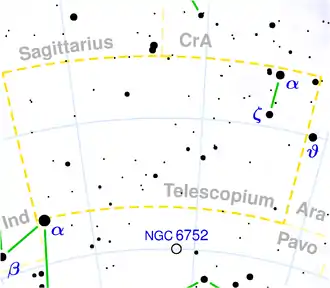Zeta Telescopii
ζ Telescopii (Zeta Telescopii; kurz ζ Tel) ist mit einer scheinbaren Helligkeit von 4,13m der zweithellste Stern des nur vom Südhimmel aus sichtbaren Sternbilds Teleskop.[2] Dennoch erscheint der orangefarben leuchtende Stern dem bloßen Auge relativ lichtschwach. Nach im Dezember 2020 veröffentlichten Auswertungen der Messergebnisse der Raumsonde Gaia ist der Stern etwa 122 Lichtjahre von der Erde entfernt.[1] Er dürfte ein Einzelstern sein.[8]
| Stern Zeta Telescopii | |||||||||||||||
|---|---|---|---|---|---|---|---|---|---|---|---|---|---|---|---|
| |||||||||||||||
| AladinLite | |||||||||||||||
| Beobachtungsdaten Äquinoktium: J2000.0, Epoche: J2000.0 | |||||||||||||||
| Sternbild | Teleskop | ||||||||||||||
| Rektaszension | 18h 28m 49,86s [1] | ||||||||||||||
| Deklination | -49° 04′ 14,1″ [1] | ||||||||||||||
| Helligkeiten | |||||||||||||||
| Scheinbare Helligkeit | 4,13 mag [2] | ||||||||||||||
| Spektrum und Indices | |||||||||||||||
| B−V-Farbindex | +1,02 [3] | ||||||||||||||
| U−B-Farbindex | +0,82 [3] | ||||||||||||||
| Spektralklasse | K1 III-IV [4] | ||||||||||||||
| Astrometrie | |||||||||||||||
| Radialgeschwindigkeit | (−30.6 ± 0.7) km/s [5] | ||||||||||||||
| Parallaxe | (26.6984 ± 0.1406) mas [1] | ||||||||||||||
| Entfernung | (122 ± 1) Lj (37.5 ± 0.2) pc [1] | ||||||||||||||
| Visuelle Absolute Helligkeit Mvis | 1,17 mag [2] | ||||||||||||||
| Eigenbewegung [1] | |||||||||||||||
| Rek.-Anteil: | (+139.344 ± 0.121) mas/a | ||||||||||||||
| Dekl.-Anteil: | (−229.884 ± 0.108) mas/a | ||||||||||||||
| Physikalische Eigenschaften | |||||||||||||||
| Masse | 1.53 M☉ [2] | ||||||||||||||
| Radius | 9.3 R☉ [6] | ||||||||||||||
| Effektive Temperatur | (4801 ± 39) K [7] | ||||||||||||||
| Andere Bezeichnungen und Katalogeinträge | |||||||||||||||
| |||||||||||||||
ζ Telescopii ist ein leuchtkräftiger Riesenstern vom Typ der Red Clump Stars, in dessen Zentralbereich der Prozess des Heliumbrennens stattfindet.[2] Er wird zur Spektralklasse K1 und Leuchtkraftklasse III oder IV gerechnet.[4] Messungen ergaben, dass sein Winkeldurchmesser ungefähr 2,16 ± 0,11 Millibogensekunden beträgt.[9] Aus seiner relativ genau bekannten Entfernung ergibt sich damit sein realer Durchmesser zu circa 9 Sonnendurchmesser. Seine Masse beträgt etwa 1,53 Sonnenmassen.[2]
Weblinks
Anmerkungen
- Gaia early data release 3 (Gaia EDR3) für ζ Tel, Dezember 2020
- Y. J. Liu, G. Zhao, J. R. Shi, G. Pietrzyński, W. Gieren: The abundances of nearby red clump giants. In: Monthly Notices of the Royal Astronomical Society. 382, Nr. 2, 2007, S. 553–566. bibcode:2007MNRAS.382..553L. doi:10.1111/j.1365-2966.2007.11852.x. (Datensatz auf VizieR).
- H. L. Johnson, B. Iriarte, R. I. Mitchell, W. Z. Wisniewskj: UBVRIJKL photometry of the bright stars. In: Communications of the Lunar and Planetary Laboratory. 4, Nr. 1, 1966, S. 99–110. bibcode:1966CoLPL...4...99J. (Datensatz auf VizieR).
- R. O. Gray, C. J. Corbally, R. F. Garrison, M. T. McFadden, E. J. Bubar, C. E. McGahee, A. A. O'Donoghue, E. R. Knox: Contributions to the Nearby Stars (NStars) Project: spectroscopy of stars earlier than M0 within 40 pc-The Southern Sample. In: The Astronomical Journal. 132, Nr. 1, 2006, S. 161–170. arxiv:astro-ph/0603770. bibcode:2006AJ....132..161G. doi:10.1086/504637. (Datensatz auf VizieR).
- G. A. Gontcharov: Pulkovo compilation of radial velocities for 35495 Hipparcos stars in a common system. In: Astronomy Letters. 32, Nr. 11, November 2006, S. 759–771. arxiv:1606.08053. bibcode:2006AstL...32..759G. doi:10.1134/S1063773706110065. (Datensatz auf VizieR).
- Gaia data release 2 (Gaia DR2) für ζ Tel, April 2018
- S. Alves, L. Benamati, N. C. Santos, V. Zh. Adibekyan, S. G. Sousa, G. Israelian, J. R. De Medeiros, C. Lovis, S. Udry: Determination of the spectroscopic stellar parameters for 257 field giant stars. In: Monthly Notices of the Royal Astronomical Society. 448, Nr. 3, April 2015, S. 2749–2765. arxiv:1503.02556. bibcode:2015MNRAS.448.2749A. doi:10.1093/mnras/stv189. Von dieser Arbeit sind hier die T13-Linien-Daten der Tabelle angeführt.
- P. P. Eggleton, A. A. Tokovinin: A catalogue of multiplicity among bright stellar systems. In: Monthly Notices of the Royal Astronomical Society. 389, Nr. 2, September 2008, S. 869–879. arxiv:0806.2878. bibcode:2008MNRAS.389..869E. doi:10.1111/j.1365-2966.2008.13596.x.
- A. Richichi, I. Percheron, M. Khristoforova: CHARM2: An updated Catalog of High Angular Resolution Measurements. In: Astronomy and Astrophysics. 431, Nr. 2, Februar 2005, S. 773–777. bibcode:2005A&A...431..773R. doi:10.1051/0004-6361:20042039. (Datensatz auf VizieR).
